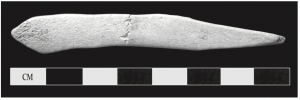Archaeology has been defined as the study of past societies through the remains of their artifacts (Renfrew and Bahn 2018). While many perceive archaeology as one way of discovery and analysis applied to different ancient societies and cultures, there is actually many specialties within the field that help give insight. One unique example of this is zooarchaeology which is defined as the study of non-human animal remains within the context of past societies and cultures (Painter 2016). Past animal remains can give a lot of insight into the environment that humans lived in and more importantly how they utilized it.
One interesting study performed by researchers at Binghamton University used the trading of venison to better understand interactions between English Colonists and Native Americans in Virginia’s Potomac River Valley in the late 1600s (Hatch 2012). To begin this investigation, Doctor Hatch performed an excavation at a location referred to as the Hallowes Site. The Hallowes site is located around the delta of the Potomac River on the border of Virginia and Maryland. At this location, Doctor Hatch was able to find artifacts and skeletal remains of deer. Through analysis of the remains, it was found that deer forequarters and hindquarters were found in the highest frequency. One artifact of importance was identified to be a bone awl (Figure 2).

Figure 2: Bone awl recovered at the Hallowes Site. Photo by the Virginia Department of Historic Resources.
From this evidence and historical records, it was postulated that this location was used for processing the hunted deer for the parts that would be traded to the colonists. This was supported by there being a very high frequency of certain skeletal remains. Also, the identification of Native American tools confirmed that the site was used by the tribes of this area. One question that was created from this investigation was what happened to the rest of the deer that was not left at this location? Archaeologists thought that the heads were kept by the Native Americans due to the importance of the brains for the hide-tanning process. By keeping the parts of the animals that the colonists did not want to buy, the Native Americans were able to use the skin and brain to create leather and produce a product for them to sell and use for themselves. This study represents one aspect of how zooarchaeology can be used to better comprehend a part of the past.
Zooarchaeology is just one example of the many specialties within archaeology that allows for different perspectives to be seen and ultimately give a clearer image of the past. With the development of new technology and information being learned, the field of archaeology and the specialties within it are constantly growing and improving.
Links of interest:
https://trace.tennessee.edu/cgi/viewcontent.cgi?article=5075&context=utk_gradthes
References
Hatch, D. Brad. 2012. “Venison Trade and Interaction between English Colonists and.
Native Americans in Virginia’s Potomac River Valley.” Northeast Historical
Archaeology 41 (1): 18–49. https://doi.org/10.22191/neha/vol41/iss1/3.
Painter, Autumn. 2016. “Zooarchaeology: The Study of Animal Bones and How It Is
Done.” MSU Campus Archaeology Program (blog). November 29, 2016.
http://campusarch.msu.edu/?p=4531.
Renfrew, Colin, and Paul G. Bahn. 2018. Archaeology Essentials: Theories, Methods,
Practice with 303 Illustrations. Fourth edition. London: Thames & Hudson Ltd.



